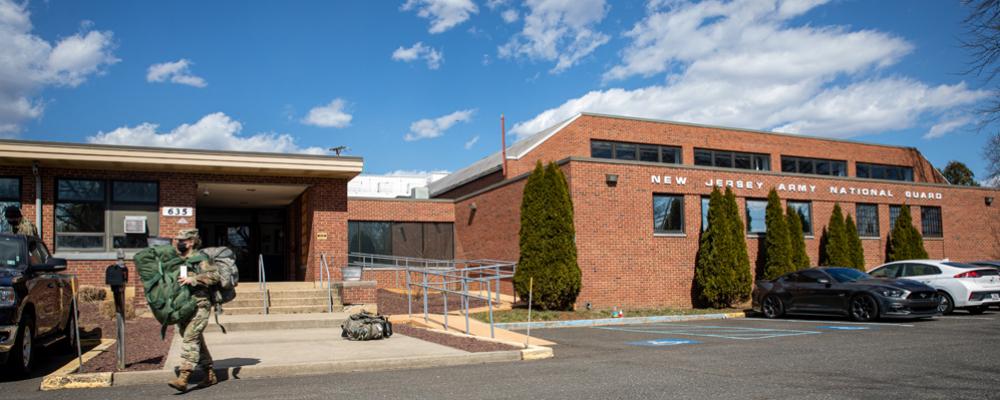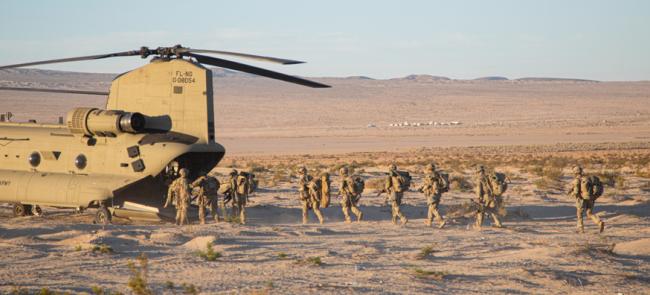
Building Concerns
In Delaware, half-century-old Army National Guard armories continue to erode.
“The roofs don’t last forever,” said William Cost, the construction and facilities management officer for the Delaware Army Guard. “You end up with a lot of sewer problems — pipelines underneath the building that have collapsed or have roots growing through them.”
But fixing leaking roofs and sewer lines is only a partial remedy for what ails these and so many other Army Guard facilities nationwide.
Some lack the power supplies and network connectivity required for a growing array and simulators and computer systems. Others have faulty heating and cooling systems, outdated plumbing, inadequate classrooms and/or crumbling parking lots. And as women enter traditionally male-only combat units, few armories have restrooms and locker rooms for them.
The Army Guard has also had facilities severely damaged by recent hurricanes and destructive storms. There are even some with health concerns, such as lead dust, asbestos or mold.
Then there are the storage issues. Armories designed and built to house Korean War-era units simply lack the space for the latest equipment. Their maintenance shops are also too small for larger, modern vehicles. And many lack the required physical security.
New Jersey is one of the states grappling with shortage of space, says Lt. Col. Viviene McNamara, the director of the Construction and Facilities Management Office for the New Jersey Army Guard.
“We have infantry brigade combat team units here and they have ever more requirements,” she says. “They need highly technical equipment, and the facilities that were inadequate 10 years ago are even more inadequate now.”
“By and large, our facilities were constructed to support a Cold War-era strategic reserve,” says Maj. Gen. David Mikolaities, the adjutant general of New Hampshire and chair of the Adjutants General Association of the United States Infrastructure, Facilities & Financial Oversight Committee.
The data bears this out. The average Army Guard readiness center is 46 years old, according to the National Guard Bureau.
The solution is a steady infusion of military construction dollars to bring facilities up to date. Annual MILCON appropriations have ticked up in recent years (the Army Guard received $349 million for fiscal 2021), but they are a fraction of need.
That figure, according to the 2014 Army National Guard Readiness Center Transformation Master Plan, is about $1.4 billion per year for 15 consecutive years.
The NGB team determined it would take more than $20 billion to meet 80% of the space requirements for Army Guard armories and increase their condition index to “fair.” The report calls that “affordable readiness.” Anything better would cost significantly more.
The plan was developed for the secretary of the Army at the direction of Congress. It was a product of leader input, soldier surveys, independent facility assessments, and a look at future mission requirements and demographic trends.
In addition to calling for the construction of new readiness centers, the plan would rehab others and divest some 600 armories nationwide. The Army Guard footprint would reduce from nearly 2,200 readiness centers, the Guard’s preferred name for armories, to about 1,600.
Army leaders, no doubt, have seen the plan, but the $349 million in fiscal 2021 is the closest that Army Guard MILCON appropriations have gotten to the $1.4 billion since the master plan was published.
Congress has the final say on the budget, and lawmakers could add to Army MILCON plans in the president’s budget request. So far, that isn’t happening to a large degree. Why? One reason is, lawmakers would have to repurpose money from elsewhere in the budget, which they are reluctant to do.
Some say the root of the problem lies in perception: On the campaign trail, infrastructure lacks glamour.
“It’s not a weapon system. It’s not a plane or a tank,” Mikolaities says. Even absent the appeal of gadgetry, he adds, lawmakers still should be engaged. “This occurs in every congressional district. It should have universal, bipartisan support.”
Things could be different during the deliberations on the fiscal 2022 budget. President Joe Biden is pushing infrastructure. Meanwhile, it’s likely congressional earmarks will return. They were banned in 2010 as wasteful, but in the last seven years of their use, they provided the funds for as much a third of all new Army Guard readiness centers, according to NGAUS figures.
Congress was able to find $15 million in fiscal 2021 dollars for the Army Guard to update its readiness center transformation master plan.
Mikolaities and others involved in Army Guard construction and facilities management believe they know what the update will find: The overall condition of armories has further deteriorated, adversely effecting readiness, recruiting and retention, and the cost of fixing or replacing them has only gotten more expensive.
By and large, our facilities were constructed to support a Cold War-era strategic reserve.
—Maj. Gen. David Mikolaities, the adjutant general of New Hampshire and chair of the Adjutants General Association of the United States Infrastructure, Facilities & Financial Oversight Committee
THE ARMY GUARD has armories that date back to the 19th century.
One is the Connecticut Street Armory, a massive structure that looks like a massive castle in Buffalo, New York. It opened in 1899. The state of New York paid most of the construction costs with the members of the New York Guard’s 74th Regiment covering the rest.
Defense dollars didn’t help build Guard armories until 1950, when Congress, at the behest of NGAUS, passed the first armory construction bill. It provided federal funds amounting to 75% of the cost of new armories on state land and 100% if required due federal force structure changes.
The provision triggered a building boom. Between 1950 and 1960, the Army Guard built 781 facilities, according to NGB. Most were constructed to last approximately 55 years. The Guard has not seen anything close to a comparable infusion of construction funds since.
The Army Guard did receive $874 million for military construction in fiscal 2011; however, appropriations fell quickly along with overall defense spending in the sequestration years, bottoming out at $133 million in 2015. They have ticked up in recent years with higher toplines, but not significantly as the Army prioritizes equipment modernization.
Today, the states and territories compete against each other for scarce MILCON dollars. Fiscal 2021 appropriations will fund major Army Guard construction projects in 16 states, Puerto Rico and the U.S. Virgin Islands. They include nine readiness centers, four vehicle maintenance shops, an Army aviation support facility and an enlisted barracks for transient training.
This also means 34 states, Guam and the District of Columbia received nothing for major construction projects.
Every year, the 54 states, territories and the District of Columbia compete for authorization of major projects 10 or so years out. At the current approval rate,between 12 and 16 get the go ahead, say state Army Guard construction and facilities management officials.
NGB rates projects on how well they fit into the Guard mission, how well they fit into the Army’s facility investment strategy, how ready they are to begin construction and whether the state or territory received construction money the previous year.
Of the 16 states and two territories approved for major construction projects for fiscal 2021, only Mississippi and Nebraska also had projects in the fiscal 2020 budget.
The Air Guard also has a significant construction backlog — more than $2 billion. Fiscal 2021 defense appropriations include $64 million for the Air Guard or $100 million less than in fiscal 2020. The funds will cover an F-35 simulator facility in Alabama, F-16 mission training centers in Maryland and Texas, and a space control facility in Guam.
IN ADDITION to several major projects awaiting construction funds, every state and territory has many smaller projects, most of them repairs needed to extend the life of existing facilities.
For such projects, states and territories use whatever state and territorial dollars may be available and federal funds in in the Unspecified Minor Military Construction account, which is part of the annual MILCON appropriation. For the Army Guard in fiscal 2021, it was nearly $46 million, which reflects a $13 million congressional add to the president’s budget request.
UMMC funds can be simpler to obtain. The secretary of the Army is approval authority for projects of less than $6 million as opposed to Congress, which means they don’t have to be placed in five-year Future Year Defense Program for budgeting.
But here, too, needs dwarf available funds, which forces some tough decisions.
“If we have 50 projects listed and we know we might be able to pull off 10 or 12 a year, we have to bubble up the most important: either what’s the most important, or what’s going to fail first,” says Cost, the construction and facilities management officer for the Delaware Army Guard.
“Is this something that impacts life, health and safety, or is it a code compliance issue? Or is it something that supports another project that’s coming up soon? We have to take a strategic approach.”
Mikolaities, the chair of the AGAUS Infrastructure & Facilities Committee, would like to see larger UMMC appropriations and higher cost limits.
“You could use that to really revitalize and expand an existing armory that you think you need to keep, because it’s in the right location with the right demographics, for the right population density to support your state,” he says.
In Delaware, Cost agrees. “I might need a new building that is going to cost $25 million, but I might also have an old building where I just need another 10,000 square feet on it, and I can do that for under $6 million,” he says. “You can do an awful lot with the infrastructure you have, if you can keep it from collapsing in on itself. You’ve already got a heating plant in there. You’ve got your electrical all ready. So for an additional $6 million, you save on that $25 million it would have cost to build from the ground up.”
Another possibility involves the Guard leveraging the excess commercial real estate that will likely hit the market as remote work becomes more of a norm in the post-COVID-19 era.
Mikolaities says he is exploring the possibility of a policy change that would allow federal funds to be used to buy commercial property for Guard use.
“We all know that with COVID the corporate footprint will be changing,” he explains. “Does that create an opportunity where you could buy a commercial building versus building a new milcon? And does that in turn help us address the readiness center deficit that we currently have?”
With greater flexibility, Mikolaities suggests, the Guard could buy a $2 million office building rather than investing $20 million in construction — a big potential win for taxpayers. The administrative space would be readily usable, and renovations could deliver things like dining spaces and motor pool facilities at relatively low cost.
With MILCON dollars scarce, Army Guard construction and facilities management officials agree that more creativity and flexibility are needed.
ADAM STONE is an Annapolis, Maryland-based freelance writer who specializes in defense issues. He can be reached via [email protected].
THE NGAUS TAKE
The services need to increase their military construction funding for the National Guard. The 2014 Army National Guard Readiness Center Transformation Master Plan provides the roadmap for the Army Guard. Nothing has really changed since its release, except that most Army facilities have seven more years of wear and tear. And the cost of inaction is only increasing. The Air Guard also has a significant construction backlog — more than $2 billion in projects. Military construction may not be as exciting as next-generation fighters and combat helicopters, but it plays an important role in combat readiness. It also affects recruiting and retention. This is why MILCON continues to be NGAUS legislative priority.



